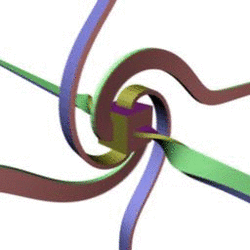Physics:Anti-twister mechanism
The anti-twister or antitwister mechanism is a method of connecting a flexible link between two objects, one of which is rotating with respect to the other, in a way that prevents the link from becoming twisted. The link could be an electrical cable or a flexible conduit.
This mechanism is intended as an alternative to the usual method of supplying electric power to a rotating device, the use of slip rings. The slip rings are attached to one part of the machine, and a set of fine metal brushes are attached to the other part. The brushes are kept in sliding contact with the slip rings, providing an electrical path between the two parts while allowing the parts to rotate about each other.
However, this presents problems with smaller devices. Whereas with large devices minor fluctuations in the power provided through the brush mechanism are inconsequential, in the case of tiny electronic components, the brushing introduces unacceptable levels of noise in the stream of power supplied. Therefore, a smoother means of power delivery is needed.
A device designed and patented[1] in 1971 by Dale A. Adams and reported in The Amateur Scientist in December 1975,[2] solves this problem with a rotating disk above a base from which a cable extends up, over, and onto the top of the disk. As the disk rotates the plane of this cable is rotated at exactly half the rate of the disk so the cable experiences no net twisting.
What makes the device possible is the peculiar connectivity of the space of 3D rotations, as discovered[3] by P. A. M. Dirac and illustrated in his Plate trick (also known as the string trick or belt trick).[4] Its covering Spin(3) group can be represented by unit quaternions, also known as versors.
See also
- Quaternions and spatial rotation
- Candle dance
References
- ↑ Adams, Dale A., "Apparatus for providing energy communicating between a moving and a stationary terminal", US patent 3586413, published 25 March 1969, issued 22 June 1971
- ↑ Stong, C. L. (December 1975). "Amateur Scientist: Diverse Topics, Starting with How to Supply Electric Power to Something That Is Turning". Scientific American 233 (6): 120–123. doi:10.1038/scientificamerican1275-120. http://www.scientificamerican.com/article/the-amateur-scientist-1975-12/. Retrieved January 11, 2016.
- ↑ The earliest published mention is “On a string problem of Dirac” by M.H.A. Newman, J. London Math. Soc., vol. 17 (1942). Dirac called it the “scissors puzzle” in a letter to Newman seven years before that. "The Dirac String Trick". http://ariwatch.com/VS/Algorithms/DiracStringTrick.htm.
- ↑ Holroyd, Alexander E. (2022-04-18). "The spinor linkage – a mechanical implementation of the plate trick". Journal of Mathematics and the Arts: 1–29. doi:10.1080/17513472.2022.2045049. ISSN 1751-3472. https://doi.org/10.1080/17513472.2022.2045049.
External links
 |


